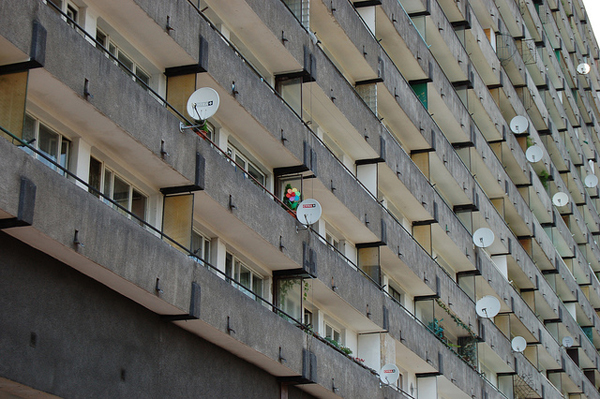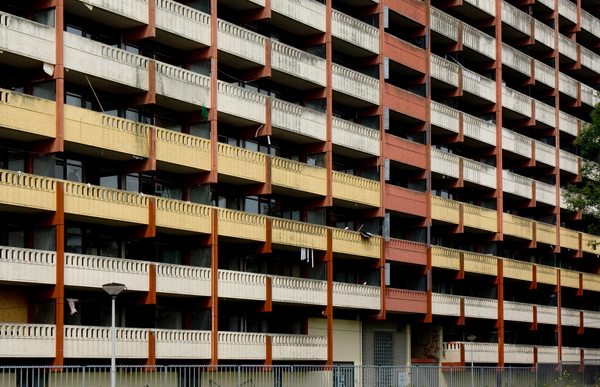The human condition, being disappointing, unpredictable and overly dependent on accidental factors, may often appear undesirable. Hence the need to put things in order. If one leaves the mess aside and begins anew, according to clear guidelines, shouldn’t everything begin to work logically? Halciion investigates
Although the term itself was coined by Thomas More in the 16th century, ‘utopia’ became a specialty of the modern era. In the 19th century, Charles Fourier suggested that providing optimum living conditions would prompt city dwellers to cooperate for the purpose of common good; his notion of space as the motor of progress and cradle of harmonious society was then developed by the visionaries of modernism. Yet, none of these attempts proved to be successful; some would argue that the principal one is the inevitable doom utopia brings upon itself. “Utopias have something to do with failure”, wrote Frederic Jameson. Emile Cioran, disenchanted and pessimistic towards utopias (along with almost everything) found his own diagnosis:
“utopia is the grotesque en rose, the need to associate happiness – that is, the improbable – with becoming, and to coerce an optimistic, aerial vision to the point where it re-joins its own source: the very cynicism it sought to combat. In short, a monstrous fantasy”.

New dwellings for new humans
Central and Eastern Europe was, for a number of decades, an arena for a grand utopian experiment pursued by the authority-endorsed followers of modernist ideas; from the concept of raising an industrious, collective-minded ‘New Man’, through to the reorganisation of space for these improved citizens. Over the years of Communist rule, the towns and cities of East Germany, Russia and Poland were increasingly covered with neat rectangles, carefully measured to meet the demands of an average resident. By ‘average’, designers meant ‘everyone’. One of the most movingly naïve pursuits of modernism was the assumption that human beings need a precisely measured amount of space, fresh air and access to nature in order to thrive – a belief that ‘one size fits all’. Le Corbusier’s ideas of a functional living space covering all basic needs were enthusiastically adopted in progress-oriented countries. Due to the entirely mundane reasons of time and money shortages, these brave new urban spaces turned out in practice to be less Unit d’Habitation, than literally ‘einsturzende neubauten’ (‘collapsing new buildings’). Utopia had cracking walls and crumbling balconies. It filled the lungs with asbestos and painted the landscape in monotonous greys. Available space, instead of optimum, barely covered the minimum: in Poland, government planners enforced norms of living space per person which were suitable for hand-to-mouth existence only – a family of three had to fit into 38 square metres.
Yet surprisingly, even the visionary strain of architectural modernism eventually crashed not because of physical limitations, but rather against the obstacle of its inhabitants. Polish architects Oskar and Zofia Hansen were known as parents of the ‘Open Form’, a concept in which architecture and wider urban space is not a finite construct, but may be available for modification. Hence their projects – settlements in Warsaw and Lublin – contained open spaces for encounters: courtyards, piazzas and corridors, designed for inhabitants to freely roam and enrich the ‘inhuman’ concrete structure with the spirit of spontaneous community. Soon, however, residents divided the corridors with grilles, locking themselves away in their own compartments. This scenario seems to reoccur throughout the history of modern architecture – once the ideal location is prepared, it surprisingly lacks participants. Utopian constructs seem to run contrary to the expectations of the proposed inhabitants – Egyptian visionary Hassan Fathy designed the model village of New Qurna in the 1950s, combining respect for traditional building techniques with modern urban planning, and yet almost no-one was interested in moving in, as potential residents preferred locations more convenient for the souvenir trade. New Qurna became a monument (or museum) of visionary thinking, before it even had the chance of coming to life.

In other European cities, utopian settlements took unexpected directions. Amsterdam’s Bijlmermeer district, originally designed as an exemplary functionalist ‘radiant city’, was supposed to appeal to the orderly, suburban middle classes with its high-rise, spacious blocks and convenient pathways. Rejected by the original target group, the Bijlmer soon became home to the underprivileged share of Amsterdam’s population, in particular immigrants from Suriname. Unemployment, poverty and distance from the city (causing gradual social exclusion) turned the district into a dystopian satellite, and only recently has the Bijlmer gained new life as a thriving multicultural neighbourhood. This eventual success runs parallel with the removal of utopian high-rise structures and their replacement with cosier, smaller ones. A similar turn of events was observed in Berlin’s modernist suburb Gropiusstadt, which gained notoriety via Christiane F. and her Wir Kinder von Bahnhof ZOO. ‘Ideal’ settlements, one may read between the lines of the book, are desolate enough to make their children go astray and seek a softer, chemically-induced utopia elsewhere.
Frederic Jameson believed that modernist utopias were wrong in their claims because of an inherent dehumanizing quality which proclaimed a mass, undifferentiated approach to humanity. Underestimating variety provides the deathblow. When utopia fails, its empty shells offer shelter for a swarming diversity of distinctly human qualities: imperfection, trial-and-error, makeshift fixing. In Central Europe, futuristic concrete halls were either left empty, occasionally haunted by masked graffiti bombers and drinking youths, or crowded with tiny business owners, hastily concocting their kiosks out of cardboard, scrap metal and fruit crates.
The actual virtual
The most recent embodiment of utopian thinking, and the latest disappointment, isn’t related to urban planning, architecture, or a particular society per se; when we look back at the 1990s, we begin to recall visions of the Internet as a source of common enlightenment. The early days of the World Wide Web carried a strain of anarchist idealism (the belief in innate human responsibility and goodness) and a hint of Libertarian values, Robert Anton Wilson style. “Here science and art, media and mind combine in a cyborg frenzy to create this replicant cousin to cyberpunk and hacking”, wrote John Frost in the Cyberpoet’s Guide to Virtual Culture. Douglas Rushkoff’s key mid-90s opus Cyberia optimistically predicted that the Web would become a tool which empowers people to speak up, act and create. Since then, the once-foreseen ‘virtual’ world has come to mirror the mundanity of the so-called ‘real’ world, and instead of offering an alternative has become another facet of the offline, overtaken by the manipulative presence of mainstream companies and media, along with the gossip, urban legend and superstitious matter of everyday anthropology. Nothing summarised the state of things better than the multiple meaning of the word ‘virtual’ – both referring directly to the ‘actual’, as well as to the computer-generated simulation of reality. The very same Rushkoff, formerly a starry-eyed proponent of virtual culture, recognized the danger as early as 1999, warning of the Internet becoming a manipulation tool for coercive marketing purposes. Observing Webspace being taken over by a multitude of incidental messages, banal memes, pop-ups, spam and irrelevant links brings to mind the fall of the 20th century’s precisely-measured urban spaces. When oppressive political order and official propaganda fell apart, a new type of persuasion quickly found its way in. First – shady cults, miracle therapies and financial pyramids, later the shiny world of advertising, increasingly sly and cunningly disguised.

Utopia is here
Nowadays, nostalgia reaches back towards the utopias of yore. Central and Eastern Europe, where until recently the legacy of modernism was dismissed as the unwanted memorabilia of a former regime, now reclaims it as part of its own identity. This turnaround is noticeable in protests against the removal of iconic 60s and 70s architecture, the theme of exhibitions such as Sounding the Body Electric in Łódź Museum of Modern Art, or the work of artists like Nicolas Grospierre, who examines the legacy of past dreamers and the discrepancy between idealist visions and their application. On an international scale, multidisciplinary genres such as hauntology, or the renewed interest in the past-decades’ science fiction and futurology – most recently the 1990s technoparadise (apparent in current electronic music – see James Ferraro, Maria Minerva and Fatima Al Qadiri), seem to explore the same notions. Susan Sontag once wrote about utopia and nostalgia as two extreme poles of the contemporary condition. A closer look may lead us to the conclusion that they are not so distant after all. **
Header image by: Andreas Levers.

















